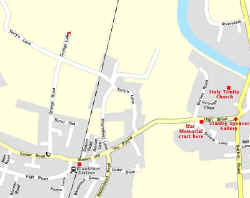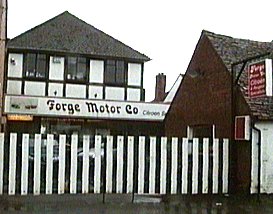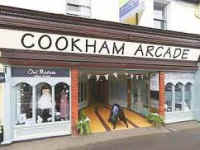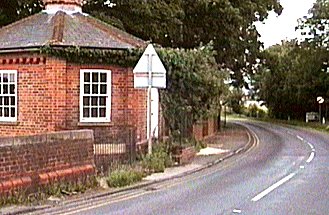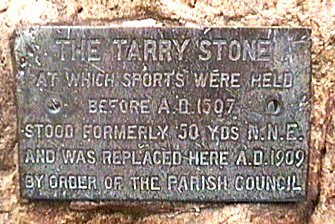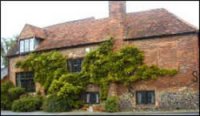Cookham Village Tour
|
|
|
Click on map for larger image |
It has been established that part of the area known as The Cookhams was inhabited by the Ancient Britons and there is evidence of a Roman occupation, but it was not until the 7th/8th centuries, following the Saxon occupation, that the village as we now know it today began to be developed; it became increasingly necessary for the Saxons to move towards the river in order to protect themselves from the marauding Danes invading the area, having come up the Thames by boat or forded it near Cookham Weir. |

War Memorial |
Let's start from the War Memorial and walk eastwards through the High Street. |
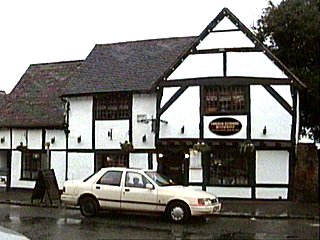
Cookham Tandoori |
On our right we come to the Old Forge, now the excellent Indian restaurant, Cookham Tandoori, one of the oldest buildings c16th century, but it is probable that there had been a forge on this site considerably earlier. |
|
Forge Garage |
Today it stands cheek by jowl with the modern though tastefully designed Forge Garage to meet present day needs. |
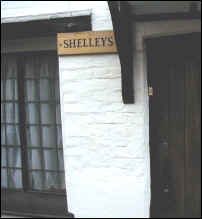
Shelleys |
Across the road are a number of very attractive cottages of varying periods, one of the oldest "Shelleys", which is 17th century, |
|
Cookham Arcade |
now flanked by the Cookham Arcade. Also on this side of the road, a few yards further on, are two Victorian cottages - their construction of brick and flint is noteworthy. |
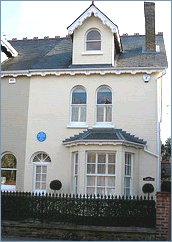
"Fernley" |
On our right we reach two Victorian semidetached houses, the first of which is "Fernley", the birthplace of Sir Stanley Spencer R.A. |

Ovey's Farm |
Opposite, don't miss Ovey's Farm, proof that farming was carried on in the heart of the the village. |
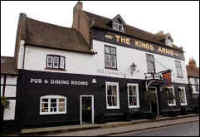
Kings Arms |
On our side of the road we have the Kings Arms, a 17th century hostelry originally called the Kings Head. There is an interesting story of one Martha Spott who minted her own half-tokens for use solely in Cookham - space does not permit of giving the full tale. |
|
Stratford's Wine Shippers |
Across the street again don't overlook The Old Butcher's Shop with it's traditional glazed tiles, now Stratford's Wine Merchant. |
|
Stanley Spencer Gallery |
Continuing up the road past the little Georgian cottages, the first evidence of the considerable development of this end of the village in the 18th century, we arrive at the Stanley Spencer Gallery - this building started life as a chapel and it was here that Stanley was brought to services by his mother. Later it became a reading room and village hall, known as the Kings Hall, until 1960. |

Wysteria Cottage |
From this corner look across the Maidenhead road to the two charming Georgian houses - further examples of development at this time. Wystaria Cottage which in recent times underwent a face life. The front wall was bowing dangerously outwards and had to be entirely rebuilt, each brick was numbered and replaced exactly in it's original position. It is said that one day's work had to be taken down and rebuilt due to a solitary brick being missed out. |
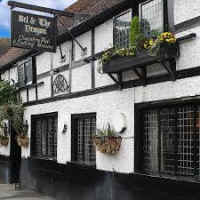
Bel & the Dragon |
Now cross the High Street to the 15th century inn "Bel and the Dragon". Here yet again the name has been changed from the original, it was first called "The Olde Bell". |
|
Vine Cottage Notice! |
Judging from the notice on the front of Vine Cottage, Cookham nightlife ended early! |
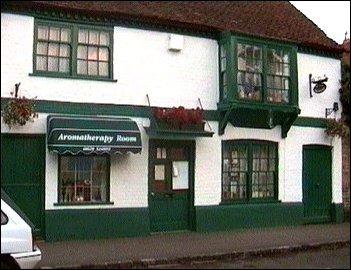
The Old Apothecary |
To the right of the inn is The Old Apothecary which was still a chemist's shop right up to the last decade. |
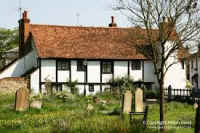 Churchgate Cottages |
Continue eastwards round the corner to your left towards the Holy Trinity Church, passing the two black and white timbered cottages. The Vicarage, now the Parish Centre, is of the Queen Anne period. |
|
Cookham Church |
Take this opportunity of paying a visit to the Church, the nave dating back to the 12th century. There is much of interest to be seen and there is a worthwhile guide telling you not only of the interior but also the church's history and that of the village. |
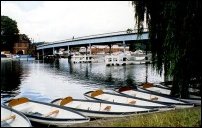
Cookham Bridge |
When leaving the church, carry on through the kissing gate to the river where you get a fine view of Cookham Bridge. The first bridge was erected in 1839 and was of wooden construction, but alas was not durable and had to be replaced 30 years later by the present iron bridge. |
|
The Toll House |
To defray the cost, a toll was levied right up to the 40's - you can see the Toll House on the north bank. It is interesting that at Cookham the north bank of the Thames is still in Berkshire, until the beginning of the 19th century Cookham was a Royal Manor and had previously been a favorite fishing ground of the Kings. To prevent poaching upon the King's preserves from the north bank, the Berkshire boundary is some yards to the north of the river bank.
|
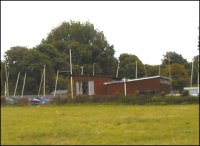
Cookham Reach Sailing Club |
It is here that in July each year one may witness the ceremony
of Swan Upping, under the direction of David Barker, the Queen's Swan Keeper and waterman,
the two City Companies of Vintners and Dyers sort out the ownership of the Cygnets.
Should you wish, you could turn left along the tow path here and return to the War Memorial via Berries Road which can easily be reached by taking another left turn before coming to the Cookham Reach Sailing Club. |

The Angel, Cookham Church |
Retrace your steps through the churchyard and at the gate you will see to your right, almost hidden by overhanging branches, a monument of an angel, the subject of one of Spencer's paintings. |
|
The Tarry Stone |
Returning towards the High Street, the large stone on the corner of Odney Lane is the Tarrystone. This was first sited between what is now the Spencer Gallery and Bel and the Dragon and was the meeting point for the local "Olympic". Past Tarrystone House you can see Lullebrook Manor, once the seat of a local squire and now owned by the John Lewis Partnership and used as a country club for their staff. The estate covers many acres and stretches as far as Mill Lane to which we are proceeding. Another opportunity to divert offers itself. Odney Lane brings you to Odney Common and Odney Weir. |
|
The Old Ship |
Walking south now towards Maidenhead we arrive at Mill Lane on the corner of which stands the Old Ship. Any number of alterations and improvements have been carried out over the years but none has destroyed its charm. The building was at one time a convent and a piscina still exists in the front downstairs room to this day. Later it became an inn - hence its name - but it has been a private house for many years; the cottage has no less than four staircases. |
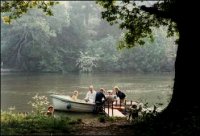
My Lady Ferry |
Three quarters of a mile down Mill Lane is one of the Thames prettiest reaches which can be approached on foot only - the Cliveden Reach - and to My Lady Ferry where the river is to be forded in pre-Norman times and more latterly a ferry was operated. |
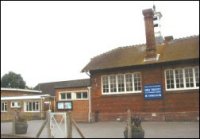
Holy Trinity School |
Turning west along School Lane we shortly come upon Holy Trinity School on your left. The original building is typical of many schools built in this Victorian era; the many additions to it are all post second World War. |
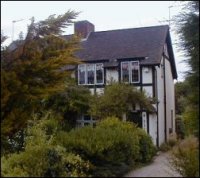
At One Time the Maltings |
Opposite the school take note of the row of cottages which had at one time been the maltings supplying the adjacent brewery. Brewing, tanning, lace making and milling of different kinds had all been carried on over the years. It was not until George III sold the manor and it became possible for people to own property that the village attracted rich merchants to come and settle. |
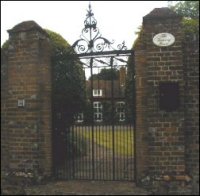
Tannery House |
A few steps further on your right are some interesting wrought iron grills in the wall of Tannery House which must at some time also have served as part of the brewery judging from the gantry to the west of it. Shoes are also said to have been manufactured here. |

Studio House |
Opposite, take a careful look at Studio House, shown at the Ideal Home Exhibition in the 30's in a style known as "ultra modern". |

Workers' Cottages |
Another few yards and two pairs of semi-detached cottages doubtless built to meet the needs of industries opposite. |
|
Victorian Houses |
These are immediately followed by two rather grander Victorian houses. |

The Brew House |
Whilst admiring the Brew House on your right, |
|
Moor End |
don't omit to cast your eyes up and across the road to Moor End and study the angles of the top floor of the house to the chimney breast. |
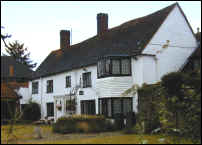
The Maltings |
And so we are back at the War Memorial, you will now understand why no mention was made earlier of The Maltings on the corner; this was of course all part of the brewery complex of School Lane. |
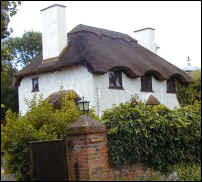
Moor Thatch |
Before going home, take a few steps along the lane to your left, Moor Thatch was once the home of Lady Spencer. |
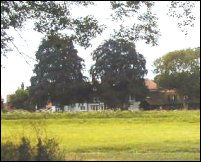
Moor Hall |
Moor Hall at the end of the lane was built as a private house in the middle of the 19th century and remained so until 1939. When owned by the Lambert family extensive additions were made including the stables. Today it is the Head-quarters and Training Centre of the Chartered Institute of Marketing. Further considerable alterations and extensions have been completed to improve the facilities. The work has been carried out with great care not to be at odds with the environment, but at the same time employing modern techniques. |
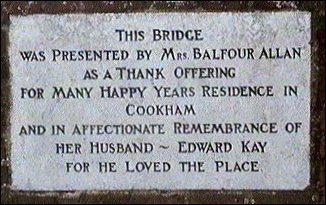
|
If you still have a little more time to spare to cross the Moor, taking the bridge over the Fleet - this bridge was a gift to the village and is invaluable in times of flood. |
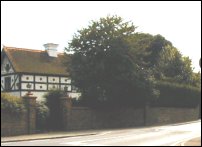
The Pound |
Stroll through the Pound - so called since it bordered the Pound Field where all the stray animals were penned. Here you will find enchanting looking houses of all periods and you will be walking back to that part of Cookham first inhabited by the Ancient Britons. |
|
Written by Desmond Atkinson Published by The Cookham Society. |
|
